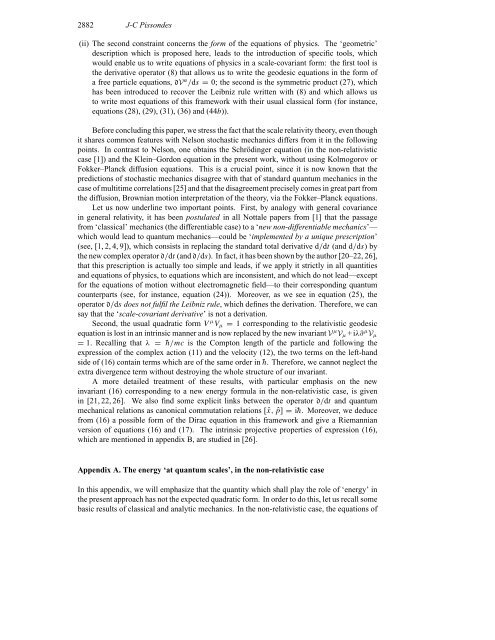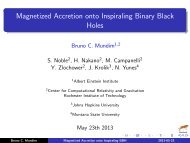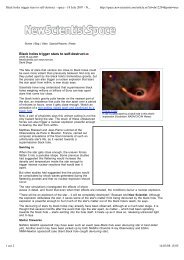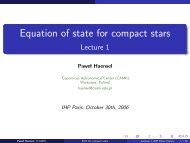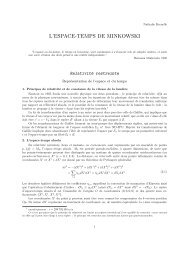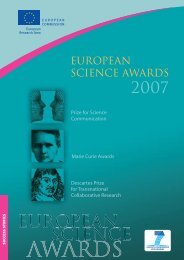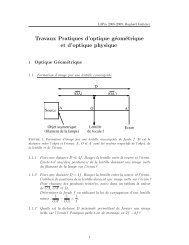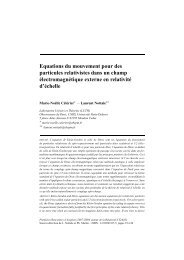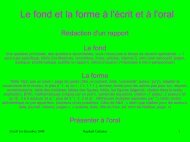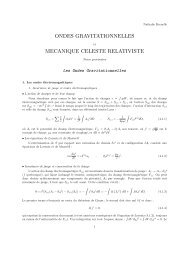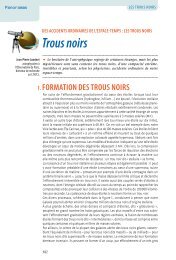J. Phys. A: Math. Gen. 32 (1999) - LUTH - Observatoire de Paris
J. Phys. A: Math. Gen. 32 (1999) - LUTH - Observatoire de Paris
J. Phys. A: Math. Gen. 32 (1999) - LUTH - Observatoire de Paris
Create successful ePaper yourself
Turn your PDF publications into a flip-book with our unique Google optimized e-Paper software.
2882 J-C Pisson<strong>de</strong>s<br />
(ii) The second constraint concerns the form of the equations of physics. The ‘geometric’<br />
<strong>de</strong>scription which is proposed here, leads to the introduction of specific tools, which<br />
would enable us to write equations of physics in a scale-covariant form: the first tool is<br />
the <strong>de</strong>rivative operator (8) that allows us to write the geo<strong>de</strong>sic equations in the form of<br />
a free particle equations, dV α /ds = 0; the second is the symmetric product (27), which<br />
has been introduced to recover the Leibniz rule written with (8) and which allows us<br />
to write most equations of this framework with their usual classical form (for instance,<br />
equations (28), (29), (31), (36) and (44b)).<br />
Before concluding this paper, we stress the fact that the scale relativity theory, even though<br />
it shares common features with Nelson stochastic mechanics differs from it in the following<br />
points. In contrast to Nelson, one obtains the Schrödinger equation (in the non-relativistic<br />
case [1]) and the Klein–Gordon equation in the present work, without using Kolmogorov or<br />
Fokker–Planck diffusion equations. This is a crucial point, since it is now known that the<br />
predictions of stochastic mechanics disagree with that of standard quantum mechanics in the<br />
case of multitime correlations [25] and that the disagreement precisely comes in great part from<br />
the diffusion, Brownian motion interpretation of the theory, via the Fokker–Planck equations.<br />
Let us now un<strong>de</strong>rline two important points. First, by analogy with general covariance<br />
in general relativity, it has been postulated in all Nottale papers from [1] that the passage<br />
from ‘classical’ mechanics (the differentiable case) to a ‘new non-differentiable mechanics’—<br />
which would lead to quantum mechanics—could be ‘implemented by a unique prescription’<br />
(see, [1, 2, 4, 9]), which consists in replacing the standard total <strong>de</strong>rivative d/dt (and d/ds) by<br />
the new complex operator d/dt (and d/ds). In fact, it has been shown by the author [20–22, 26],<br />
that this prescription is actually too simple and leads, if we apply it strictly in all quantities<br />
and equations of physics, to equations which are inconsistent, and which do not lead—except<br />
for the equations of motion without electromagnetic field—to their corresponding quantum<br />
counterparts (see, for instance, equation (24)). Moreover, as we see in equation (25), the<br />
operator d/ds does not fulfil the Leibniz rule, which <strong>de</strong>fines the <strong>de</strong>rivation. Therefore, we can<br />
say that the ‘scale-covariant <strong>de</strong>rivative’ is not a <strong>de</strong>rivation.<br />
Second, the usual quadratic form V µ Vµ = 1 corresponding to the relativistic geo<strong>de</strong>sic<br />
equation is lost in an intrinsic manner and is now replaced by the new invariant V µ Vµ +iλ∂ µ Vµ<br />
= 1. Recalling that λ = ¯h/mc is the Compton length of the particle and following the<br />
expression of the complex action (11) and the velocity (12), the two terms on the left-hand<br />
si<strong>de</strong> of (16) contain terms which are of the same or<strong>de</strong>r in ¯h. Therefore, we cannot neglect the<br />
extra divergence term without <strong>de</strong>stroying the whole structure of our invariant.<br />
A more <strong>de</strong>tailed treatment of these results, with particular emphasis on the new<br />
invariant (16) corresponding to a new energy formula in the non-relativistic case, is given<br />
in [21, 22, 26]. We also find some explicit links between the operator d/dt and quantum<br />
mechanical relations as canonical commutation relations [ ˆx, ˆp] = i¯h. Moreover, we <strong>de</strong>duce<br />
from (16) a possible form of the Dirac equation in this framework and give a Riemannian<br />
version of equations (16) and (17). The intrinsic projective properties of expression (16),<br />
which are mentioned in appendix B, are studied in [26].<br />
Appendix A. The energy ‘at quantum scales’, in the non-relativistic case<br />
In this appendix, we will emphasize that the quantity which shall play the role of ‘energy’ in<br />
the present approach has not the expected quadratic form. In or<strong>de</strong>r to do this, let us recall some<br />
basic results of classical and analytic mechanics. In the non-relativistic case, the equations of


